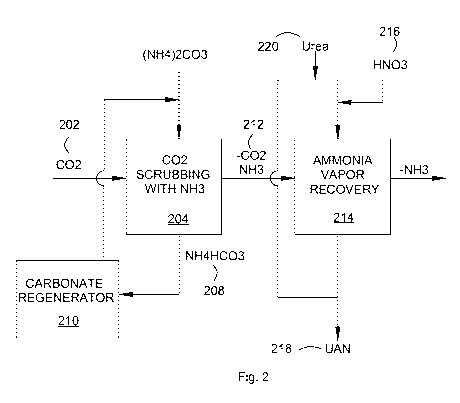Some of the information on this Web page has been provided by external sources. The Government of Canada is not responsible for the accuracy, reliability or currency of the information supplied by external sources. Users wishing to rely upon this information should consult directly with the source of the information. Content provided by external sources is not subject to official languages, privacy and accessibility requirements.
Any discrepancies in the text and image of the Claims and Abstract are due to differing posting times. Text of the Claims and Abstract are posted:
| (12) Patent Application: | (11) CA 2693466 |
|---|---|
| (54) English Title: | SCRUBBING OF AMMONIA WITH UREA AMMONIUM NITRATE SOLUTION |
| (54) French Title: | EPURATION DE L'AMMONIAC AVEC SOLUTION D'UREE ET DE NITRATE D'AMMONIUM |
| Status: | Deemed Abandoned and Beyond the Period of Reinstatement - Pending Response to Notice of Disregarded Communication |
| (51) International Patent Classification (IPC): |
|
|---|---|
| (72) Inventors : |
|
| (73) Owners : |
|
| (71) Applicants : |
|
| (74) Agent: | OYEN WIGGS GREEN & MUTALA LLP |
| (74) Associate agent: | |
| (45) Issued: | |
| (86) PCT Filing Date: | 2008-07-11 |
| (87) Open to Public Inspection: | 2009-01-15 |
| Availability of licence: | N/A |
| Dedicated to the Public: | N/A |
| (25) Language of filing: | English |
| Patent Cooperation Treaty (PCT): | Yes |
|---|---|
| (86) PCT Filing Number: | PCT/US2008/069771 |
| (87) International Publication Number: | US2008069771 |
| (85) National Entry: | 2010-01-12 |
| (30) Application Priority Data: | ||||||
|---|---|---|---|---|---|---|
|
A process for scrubbing ammonia in a C02 removal process having the steps of
absorbing (204) at least some CO2
from a gas stream (202) with an ammonium carbonate solution or a mixed alkali
solution, resulting in a release of > ammonia;
regenerating (210) ammonium.carbonate or mixed alkali solution to produce a
concentrated C02 stream; capturing ammonia with an
ammonia capture mass transfer apparatus (214). with a concentrated urea
ammonium nitrate solution; adjusting the pH of the urea
ammonium nitrate soution to between 4 .cndot. and 6 with nitric acid; and
adding urea to the urea ammonium nitrate solution, thereby
producing a urea ammonium nitrate (UAN) fertilizer product ready for
cemmercial distribution.
L'invention concerne un procédé d'épuration de l'ammoniac dans un procédé d'élimination de CO2 comportant les étapes d'absorption (204) d'au moins une certaine partie du CO2 d'un courant de gaz (202) avec une solution de carbonate d'ammonium ou une solution d'alcali mixte, conduisant à une libération d'ammoniac ; la régénération (210) du carbonate d'ammonium ou de la solution d'alcali mixte pour produire un courant de CO2 concentré ; la capture de l'ammoniac avec un appareil de transfert de masse de capture d'ammoniac (214) avec une solution concentrée d'urée et de nitrate d'ammonium ; l'ajustement du pH de la solution d'urée et de nitrate d'ammonium à une valeur comprise entre 4 et 6 avec de l'acide nitrique ; et l'ajout d'urée à la solution d'urée et de nitrate d'ammonium, produisant ainsi un produit fertilisant à base d'urée et de nitrate d'ammonium (UAN) prêt pour une distribution commerciale.
Note: Claims are shown in the official language in which they were submitted.
Note: Descriptions are shown in the official language in which they were submitted.

2024-08-01:As part of the Next Generation Patents (NGP) transition, the Canadian Patents Database (CPD) now contains a more detailed Event History, which replicates the Event Log of our new back-office solution.
Please note that "Inactive:" events refers to events no longer in use in our new back-office solution.
For a clearer understanding of the status of the application/patent presented on this page, the site Disclaimer , as well as the definitions for Patent , Event History , Maintenance Fee and Payment History should be consulted.
| Description | Date |
|---|---|
| Application Not Reinstated by Deadline | 2012-07-11 |
| Time Limit for Reversal Expired | 2012-07-11 |
| Deemed Abandoned - Failure to Respond to Maintenance Fee Notice | 2011-07-11 |
| Inactive: Office letter | 2010-04-30 |
| Letter Sent | 2010-04-30 |
| Inactive: Cover page published | 2010-03-26 |
| Inactive: Notice - National entry - No RFE | 2010-03-23 |
| Inactive: First IPC assigned | 2010-03-16 |
| Inactive: IPC assigned | 2010-03-16 |
| Inactive: IPC assigned | 2010-03-16 |
| Application Received - PCT | 2010-03-16 |
| Inactive: Single transfer | 2010-03-11 |
| National Entry Requirements Determined Compliant | 2010-01-12 |
| Application Published (Open to Public Inspection) | 2009-01-15 |
| Abandonment Date | Reason | Reinstatement Date |
|---|---|---|
| 2011-07-11 |
The last payment was received on 2010-04-01
Note : If the full payment has not been received on or before the date indicated, a further fee may be required which may be one of the following
Patent fees are adjusted on the 1st of January every year. The amounts above are the current amounts if received by December 31 of the current year.
Please refer to the CIPO
Patent Fees
web page to see all current fee amounts.
| Fee Type | Anniversary Year | Due Date | Paid Date |
|---|---|---|---|
| Basic national fee - standard | 2010-01-12 | ||
| Registration of a document | 2010-03-11 | ||
| MF (application, 2nd anniv.) - standard | 02 | 2010-07-12 | 2010-04-01 |
Note: Records showing the ownership history in alphabetical order.
| Current Owners on Record |
|---|
| POWERSPAN CORP. |
| Past Owners on Record |
|---|
| FRANCIS ALIX |
| JOANNA DUNCAN |